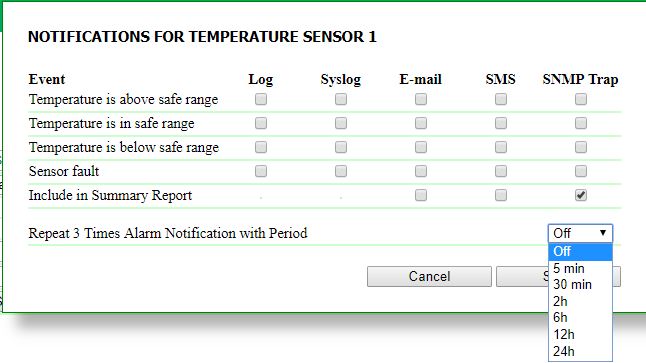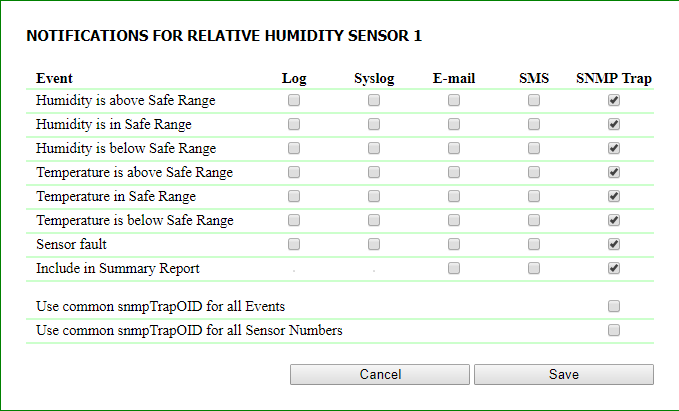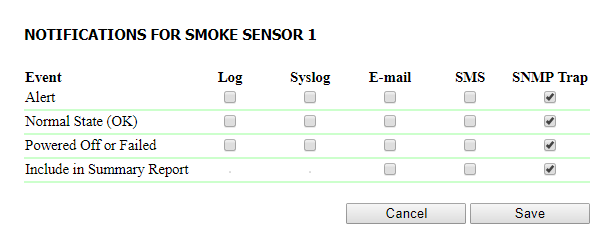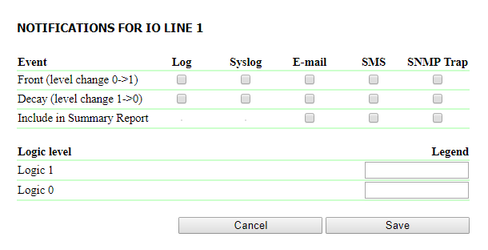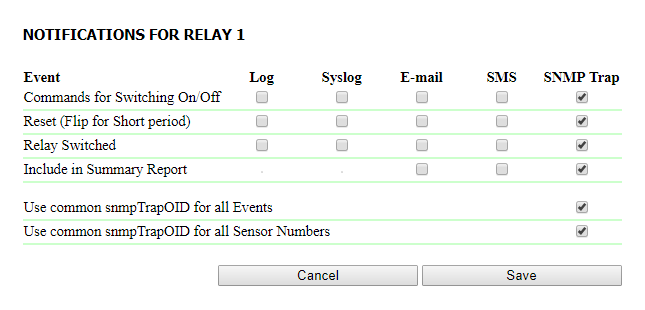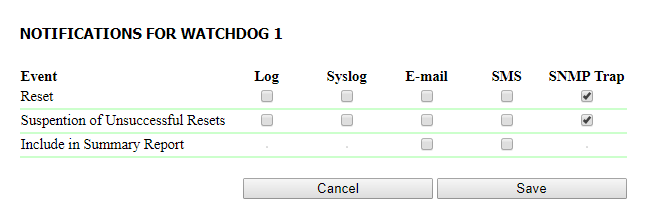[ENG] 15.2. [DKSF 54.3 IU] Configuring Sending SNMP TRAP Notifications
To access a device via an SNMP v1 protocol, there is a need to configure the next parameters using a device web interface:
- Community read – is a password that is necessary to indicate in any request for reading parameters via an SNMP protocol. It is indicated in the section «Access Restrictions» on the page «SETUP» of a device web interface;
- Community write – is a password that is necessary to indicate in any request for recording parameters via an SNMP protocol. It is indicated in the section «Access Restrictions» on the page «SETUP» of a device web interface
For a device to send SNMP TRAP notifications via an SNMP v1 protocol, there is a need to configure the next parameters of a device using a web interface:
- SNMP Trap Destination #1 – is an IP where TRAP notifications will be sent. It is indicated on the page «SETUP» of a device web interface;
- SNMP Trap Destination #2 – is a second (auxiliary) IP address where TRAP notifications will be sent. It is indicated on the page «SETUP» of a device web interface;
- Periodic Sending of Traps – enables a periodic sending of SNMP TRAP notifications about a status of sensors. Possible values are «off», «5 mins», «10 mins», «15 mins», «30 mins, «1 h», «2 h», «4 h»;
- Temperature is above safe range – is a checkbox that allows sending SNMP TRAP notifications when a temperature exceeds a top limit of a safe temperature range specified for this sensor on the page «TEMPERATURE» of a device web interface;
- Temperature is in safe range – is a checkbox that allows sending SNMP TRAP notifications when the temperature on this temperature sensor is back to the specified safe range of a normal temperature. It is configured by the button «Setup» on the page «TEMPERATURE» of a device web interface;
- Temperature is below safe range – is a checkbox that allows sending SNMP TRAP notifications when a temperature falls below a bottom limit of a safe temperature range specified for this sensor. It is configured by the button «Setup» on the page «TEMPERATURE» of a device web interface;
- Sensor Fault – is a checkbox that allows sending an SNMP TRAP notification when a sensor operation fails because the sensor fails, etc. It is configured by the button «Setup» on the page «TEMPERATURE» of a device web interface;
- Include in Summary Report – is a checkbox when checked reports about a status of a sensor will be sent via SNMP Trap. Periodic sending of SNMP Trap is configured on the page «SETUP» in the section «SNMP TRAP»;
- Repeat 3 Times Alarm Notification with Period – sets the interval for sending three-alarm notifications if readings of a temperature sensor do not come back to normal for a long time;
- Humidity is above Safe Range – is a checkbox that allows sending SNMP TRAP notifications when a value of relative humidity exceeds a top limit of a safe humidity range that is specified for the sensor. It is configured by the button «Setup» on the page «HUMIDITY» of a device web interface;
- Humidity is in Safe Range – is a checkbox that allows sending SNMP TRAP notifications when a value of relative humidity on this humidity sensor is back to a specified safe humidity range. It is configured by the button «Setup» on the page «HUMIDITY» of a web interface;
- Humidity is below Safe Range – is a checkbox that allows sending SNMP TRAP notifications when a value of relative humidity falls below a bottom limit of a safe humidity range that is specified for the sensor. It is configured by the button «Setup» on the page «HUMIDITY» of a device web interface;
- Temperature is above Safe Range – is a checkbox that allows sending SNMP TRAP notifications when a temperature value exceeds a top limit of a safe temperature range that is specified for this sensor. It is configured by the button «Setup» on the page «HUMIDITY» of a web interface;
- Temperature is in Safe Range – is a checkbox that allows sending SNMP TRAP notifications if a temperature on the sensor is back to a specified safe range of temperature. It is configured by the button «Setup» on the page «HUMIDITY» of a web interface;
- Temperature is below Safe Range – is a checkbox that allows sending SNMP TRAP notifications when a temperature value falls below a bottom limit of a safe temperature range that is specified for this sensor. It is configured by the button «Setup» on the page «HUMIDITY» of a web interface;
- Sensor Fault – is a checkbox that allows sending SNMP TRAP notifications when a sensor fails, etc. When a humidity sensor fails, two SNMP Trap notifications are sent: one on humidity and another one on temperature. It is configured by the button «Setup» on the page «HUMIDITY» of a web interface;
- Include in Summary Report – is a checkbox, when checked reports about a sensor status will be sent via SNMP Trap. Periodic sending of SNMP Trap is configured on the page «SETUP» in the section «SNMP TRAP»;
- Use common snmpTrapOID for all Events and Use common snmpTrapOID for all Sensor Numbers – are checkboxes that allow sending SNMP TRAP notifications for all events from all humidity sensors in a single snmpTrapOID notification or allow to divide events and numbers of humidity sensors by different snmpTrapOID notifications, up to totally individual ones. This allows getting individual SNMP Trap notifications for procсesing them in monitoring systems, for example, «damping of a humidity sensor 3» or «humidity sensor 2 в норме». They are configured by the button «Setup» on the page «HUMIDITY» of a device web interface;
Alert – is a checkbox that allows sending SNMP TRAP notifications if a smoke sensor determines a presence of smoke. It is configured by the button «Setup» on the page «SMOKE» of a device web interface;
Normal State– is a checkbox that allows sending SNMP TRAP notifications if a smoke sensor returned to a normal state. It is configured by the button «Setup» on the page «SMOKE» of a device web interface;
Powered Off or Failed – is a checkbox that allows sending SNMP TRAP notifications if a connection is lost or when a smoke sensor is powered off. It is configured by the button «Setup» on the page «SMOKE» of a device web interface;
- Include in Summary Report – is a checkbox, when checked reports about a status of a sensor will be sent via SNMP Trap. Periodic sending of SNMP Trap is configured on the page «SETUP» in the section «SNMP TRAP»;
- Front (level change 0->1) – is a checkbox that allows sending SNMP TRAP notifications when a logic level of an IO line is changed in the mode «input», «output», «logic output» from low to high (signal front). It is configured by the button «Setup» on the page «INPUTS» of a device web interface;
- Decay (level change 1->0) – is a checkbox that allows sending SNMP TRAP notifications when a logic level of an IO line is changed in the mode «input», «output», «logic output» from high to low (signal decay). It is configured by the button «Setup» on the page «INPUTS» of a device web interface;
- Include in Summary Report – is a checkbox when checked, reports about a status of an input line will be sent through SNMP Trap. Periodic sending of SNMP Trap is configured on the page «SETUP» in the section «SNMP TRAP»;
- Commands for Switching On/Off – is a checkbox that allows sending SNMP TRAP notifications when a relay is switched to the status «Off» or «On»;
- Reset (Flip for Short Period) – is a checkbox that allows sending SNMP TRAP notifications during short-term switching on/off a relay;
- Relay Switched – is a checkbox that allows sending SNMP TRAP notifications about triggering a relay;
- Include in Summary Report – is a checkbox, when checked reports about a status of relays will be sent through SNMP Trap. Periodic sending of SNMP Trap is configured on the page «SETUP» in the section «SNMP TRAP»;
- Use common snmpTrapOID for all events and Use common snmpTrapOID for all Sensor Numbers – are checkboxes that allow sending SNMP TRAP notifications for all events from all built-in relays by a single snmpTrapOID notification or allow dividing events and channel numbers by different snmpTrapOID notifications, up to totally individual ones. This helps to receive individual SNMP Trap for communication and processing them in the monitoring systems.
- Reset – is a checkbox that allows sending SNMP TRAP notifications when the «Watchdog» executes a reset (short-term switching on-off) a relay;
- Suspention of Unsuccessful Resets – is a checkbox, when checked a device will send notifications when it is switched from the module «Watchdog» in a standby mode. If the watchdog is not successful for a specified number of resets, then the module is switched to a standby mode;


